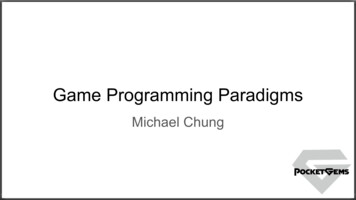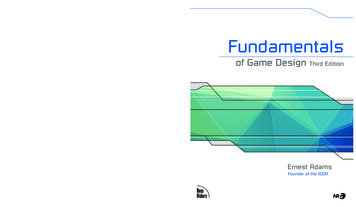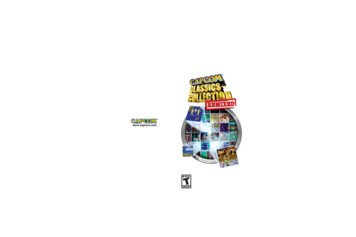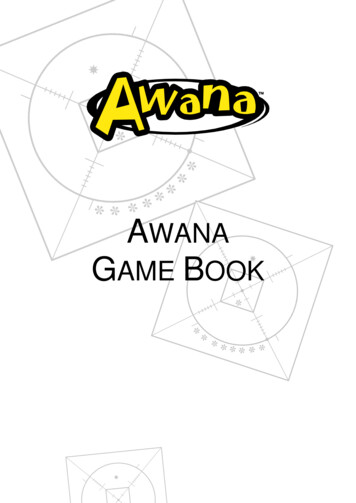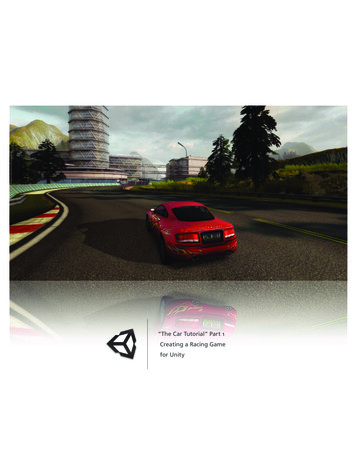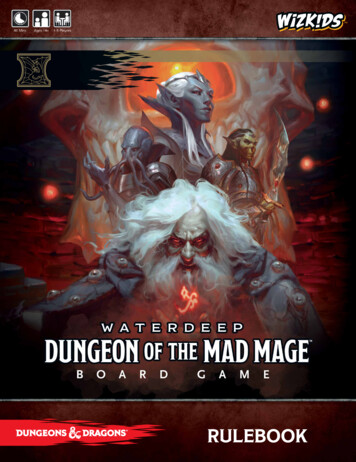
Transcription
RULEBOOK
GAME COMPONENTS43 figures: (5 Dark Blue Heroes,7 Purple Villains, and 31 GreenMonsters)TABLE OF CONTENTS8 5 HP tokensStarting Deck18 1-inch circles 1 Ally token 1 Path to the Grave token 2 False Life tokens 2 Bulwark tokens 2 Extra Attacks tokens 3 Font of Magic tokens 2 Stoneskin tokens 2 Insect Plague 1 Cloaker 1 Crystal Crown 1 Runestone 5 Sequence of Play cards42 one hundred gold pieces tokens 65 Hero Power cards16 five hundred gold pieces tokens 4 Adventure cards6 one thousand gold pieces tokens 25 Encounter cards35 condition markers 25 Monster cards 5 Advantage/Disadvantage markers 30 Treasure cards 5 Trap cards 15 Spell cards 10 Weakened markers 10 Elder Rune cards4 Healing Surge tokensAdvanced Deck22 Monster HP tokens 9 Encounter cards32 Trap tokens 24 Monster cards 8 Safe Traps 8 Treasure cards 3 Trap cards 6 Draw Traps20 Advancement tokens 5 Arrow Traps (2 Damage) 4 Regain 2 HP tokens 4 Spear Traps (3 Damage) 4 Recharge tokens 3 Fire Traps (4 Damage) 4 1 Damage tokens5 Treasure tokens5 Hero tiles4 Villain tiles1 rulebook1 adventure book1 die40 interlocking Dungeon tiles4 double-sized interlockingSpecial tiles228 cards: 4 Reroll tokens 4 2 Attack tokens 12 Stunned markers 8 Monster Advantage/Disadvantage 6 Dart Traps (1 Damage)7 Complex Trap tokens64 1 HP tokensCREDITSKevin WilsonMike Mearls, Peter Lee,Bill SlavicsekWizKids Graphic Design:Richard DadismanRulebook Cover Illustration:Cynthia SheppardAdventure Book Cover Illustration: Cynthia SheppardArtists:Cynthia Sheppard, Daarken,Shawn WoodWizKids Editorial Design:Patricia RodriguezDungeonTiles:Nakarin SukontakornGame Design:Adventure System Design: 2019 Wizards of the Coast LLC, P.O. Box 707, Renton, WA 98057-0707, U.S.A.Dungeons & Dragons, D&D, Wizards of the Coast, Waterdeep: Dungeon of theMad Mage, all other Wizards of the Coast product names, and their respective logosare trademarks of Wizards of the Coast in the U.S.A. and other countries. All Wizardscharacters, character names, and the distinctive likenesses thereof are property ofWizards of the Coast LLC. This material is protected under the copyright laws of theUnited States of America. Any reproduction or unauthorized use of the material orartwork contained herein is prohibited without the express written permission of Wizardsof the Coast LLC. This product is a work of fiction. Any similarity to actual people,organizations, places, or events included herein is purely coincidental.Inspired by the original Dungeons & Dragons Roleplaying Game adventure, Waterdeep:Dungeon of the Mad Mage .Visit our website at www.WizKids.comINTRODUCTIONGAME OVERVIEWWINNING THE GAMECampaign Play & the Advanced DeckGame SetupTo Start PlayingTaking TurnsThe Dungeon Tile StackPLAYER SETUPTHE HERO CARDPLAYER TURNHero PhaseExploration PhaseVillain PhaseMOVEMENTCondition: AdvantageCondition: DisadvantageCondition: StunnedCondition: WeakenedATTACKSExpert PowersDaily PowersUtility PowersAt-Will PowersCOMBATTargetingAC and HPAttack BonusMaking an AttackDamageCritical HitsDefeating MonstersDefeating HeroesRegaining Hit PointsHealing SurgesDisabling a TrapOther ActionsTHE MONSTER DECKTHE ENCOUNTER DECKEXPERIENCE POINTSCanceling Encounter CardsTHE TREASURE DECKTHE TRAP DECKTHE SPELL DECKPLAYING THE CAMPAIGNTown ActionsSPECIAL COMPONENT: ELDER RUNE DECKCAMPAIGN TRACKINGFREQUENTLY ASKED 10101111111212121313141414151516
INTRODUCTIONUndermountain. The legendary dungeon of the Mad Mage,Halaster Blackcloak. Although you all had different reasonsfor coming here, you recognized the same strange pull thatthe mountain exerts upon you and your new companions.Something deep within its depths is calling your name, andyou cannot help but answer.Waterdeep: Dungeon of theMad MageStrange dreams, whispers in the waking mind, our Heroes arecompelled to journey to Mount Waterdeep, and to enter theUndermountain, the ancient dwelling of Halaster Blackcloak,the Mad Mage.The entrance to the Undermountain lies in the center of afamous inn called, Yawning Portal. Our Heroes find themselvesinside the inn, ready to face their obsession.GAME OVERVIEWThe Dungeons & Dragons : Waterdeep: Dungeon of the MadMage Adventure System Game is a cooperative campaigngame. You and your fellow Heroes form an adventuring party,working as a team to succeed in the adventures that unfoldinside the dungeons and caverns of the Undermountain.Each player selects a Hero who has been drawn toUndermountain, to the Yawning Portal to explore its depths.Choose from the gnome rogue Trosper, the human sorcererMarcon, the human paladin Nayeli Goldflower, the half-elf clericCormac, or the tiefling fighter Atka. Your Heroes will ventureinto the Undermountain’s deepest depths, passing throughSkullport, delving through unexplored caverns, avoiding devioustraps, fighting monsters, and uncovering magical treasure.Once you’ve selected your Heroes, you’re ready to enter theDungeon of the Mad Mage!Exception Based GameThe Dungeons & Dragons: Waterdeep: Dungeon of the MadMage Adventure System, like the other Adventure Systemgames, is exception based. That means the cards, powers,monsters, and Special Adventure Rules may contradict the baserules of the game (this book). Whenever that happens, youshould follow the instructions on the exception even though itcontradicts the rules.Number of PlayersThe game can be played with any number of players, from 1 to 5.Each player controls one Hero—and the game does the rest!D&D Adventure SystemYou can combine this game with other D&D AdventureSystem board games to create new and unique experiences.Check out www.WizKids.com for more information.WINNING THE GAMEYou win by completing the objective in the adventure you areplaying. For example, you might have to round up bandits ordestroy a lich’s phylactery.Unless stated otherwise in an adventure, you lose if any Herois at 0 Hit Points at the start of that Hero’s turn and there areno Healing Surge tokens left to play. You also lose if you aredefeated by the adventure you are playing. Each adventure listsits specific victory and defeat requirements.Campaign Play &The Advanced DeckThe Waterdeep: Dungeon of the Mad Mage board game isintended to be played as a campaign, although you can alwaysplay any adventure as a one-shot.To support campaign play, you should separate your cards intotwo decks: The Starting Deck (cards with a white set icon #1-184)and The Advanced Deck (cards with a gold set icon #185-228).For your first game, use only cards from the Starting Deck. Aftereach adventure, follow the instructions in the Aftermath sectionto make changes to the decks, which introduce more complexeffects and more difficult challenges. As you continue to play,see “Playing the Campaign” on page 14 for more info on waysto beef up your Heroes as you get further in the adventures.3
To Start Playing:Game SetupThe Waterdeep: Dungeon of the Mad Mage game includeseverything you need to run all 13 adventures in the adventurebook. Because each adventure is different, you don’t alwaysuse every component in the box. The following componentsare usually used in every adventure. We recommend that youstore them separately so you can make it easy to set up eachadventure! Shuffle the Monster cards into their own deck. Do thesame for the Encounter cards, Treasure cards, Trap cards,Spell cards and Elder Rune cards. Place these decks in easyreach of all the players. Randomize all of the Trap tokensand keep them face down in easy reach of all the players.Complex Trap tokens are kept in a separate pile and onlycome into play when their card is drawn. Give each player a Sequence of Play card as a reminder ofhow play proceeds. Hero cards and all figures Hero Power cards 23 Dungeon tiles (representing dungeon; cavern comeslater) Entry Well Tile Place the die and the various figures in easy reach. Pick your next adventure from the adventure book. If you’replaying your first game, play Adventure 1: Mopping Up. Check the “Adventure Setup” section of the adventurebook to see if your chosen adventure calls for any of thegame pieces you set aside. Basic Encounter cards Basic Monster cards Basic Treasure cards Unless the adventure says otherwise, place the Entry Welltile in the center of the table and place two Healing Surgetokens beside it. These are the group’s surges for thisadventure. Basic Trap cards Basic Spell cards Basic Adventure cards When you choose a Hero, take that Hero’s Hero card,Power cards, and the figure that matches the Hero. Thename of each Hero is printed on the base of the figure. Elder Rune cards Trap tokens Condition markers (Advantage, Disadvantage, Stunned,and Weakened) Hit Point tokens Unless the adventure says otherwise, place each player’sHero figure on any square of the Entry Well tile. Adventuresand cards refer to the players as “Heroes.” Each Hero card tells you how many and which Powercards you can choose for that Hero. In your early games,you can use the Power cards suggested on the back ofthe adventure book. (See “Choosing Power Cards” onpage 15 for details on how to choose Power cards in latergames.) Set aside any Power cards that aren’t used in thisadventure. DieAdvantage condition marker Set up the Dungeon tile stack (the deck of tiles) using thesetup instructions in the adventure you have selected.You are now ready to begin play. The adventure tells youany other rules you need in the “Special Adventure Rules”section.Taking TurnsPlay progresses around the table, starting with a player of thegroup’s choice and then proceeding clockwise. You can alsoeach roll the die and let the player who rolled highest go first.Trap tokenStunned condition markerSet aside the remaining game pieces. You use those piecesonly if the adventure you are playing requires them (see theadventure book for details).4Your turn consists of three phases: one for your Hero, one forExploration, and a Villain Phase for the Monsters under yourcontrol.
The Dungeon Tile StackYou draw from the collected Dungeon tiles (referred to as theDungeon tile stack) to build the dungeon and cavern areas.Each time you play, the area has a different layout. The darkdungeons and dangerously populated caverns are said to bedeadly for the unprepared.The Entry Well Tile: The Entry Well tile is where the Heroesusually begin their dungeon adventures. It’s twice the size of theother tiles. The Entry Well tile and the other double-length tilesactually consist of two separate tiles that are already connected;treat each as its own tile for the purposes of movement andcounting tiles. When you start an adventure on the Entry Well tile, youcan start on either tile.Unexplored Edge: A Dungeon tile with an unexplored edge is atile where you could place a new tile. This means that an edgeof the tile is open and doesn’t have another tile adjacent to it.Tiles and SquaresGame cards refer to both tiles and squares.A tile is the basic building block of the dungeon or cavern,drawn from the Dungeon tile stack.A square is one of the spaces on a Dungeon tile.An unexplored edge is an edge of a tile without a wall that is notadjacent to another tile. There are 7 unexplored edges in thisdiagram, highlighted in blue.A tile is a component of the game board, highlighted in yellow.A square is a part of a tile, highlighted in red. The Entry Well tileis a special tile: it is treated as two tiles.Tile Features: Triangles: Each tile features a white or black triangle that isused to specify less dangerous and more dangerous tiles.When you place a new tile, the triangle points toward theunexplored edge of the tile it is attached to. If the tile hasa black triangle, you draw an Encounter card during theVillain Phase of your turn. Monster Symbols: Each tile may feature one or moreMonster spaces with ato indicate where to placeMonsters. Trap Symbols: Each tile may feature one or more Trapsquares with a X to indicate where to place Traps. Ambush Symbol: Each tile may feature a square with ato indicate where special effects happen from card effects. Treasure Symbol: Each tile may feature a square with ato indicate where to place a Chest token. When a Heroends their turn on a square containing a Chest token, heor she draws two Treasure cards and gets to keep one,discarding the other card. Then discard the Chest token. Other Features: Dungeon tiles have darkened areas representing walls and impassable areas - which cannotbe moved through. Some tiles have names to distinguishthem for use in certain adventures.When counting tiles, you do not count diagonally and you countaround walls. For example, the Grung is 3 tiles away from Atka.5
Diagonal Movement: Your Hero can move diagonally whenmoving by squares, unless the path is blocked. Your Herocannot move diagonally when moving by tiles. If you arecounting squares, your Hero can move diagonally, evenbetween tiles. If you are counting tiles, you never countdiagonally; your Hero has to move in straight lines, notdiagonal lines, when you count tiles.PLAYER SETUPPlace your Hero card (1st level) and your selected Power cardsface up in front of you.As you acquire Treasure cards, they also go face up in front ofyou.As you acquire Monster cards, place them to one side of yourHero card, in the order in which you received them.THE HERO CARDHere’s what a Hero card looks like. The parts of a Hero card arebriefly described here and explained in detail on the listed pageof this book.Hero’s Name, Race, Class, and Level: The top linesshow your Hero’s race and character class. The Hero’slevel is shown in the bottom right corner.AC (Armor Class): The Hero’s defense score. An attackhits the Hero if it equals or exceeds this number(see page 10).HP (Hit Points): The Hero’s health. Damage reducesthe Hero’s Hit Points (see page 10). A Hero can neverregain more Hit Points than his or her Hit Point total.Speed: The number of squares the Hero can move byusing a single move (see page 7).Surge Value: When a Hero is at 0 Hit Points, he or shemust use a Healing Surge token at the start of his orher next Hero Phase. After using the Healing Surgetoken, the Hero recovers this number of Hit Points(see page 10).Special Ability: Each Hero has a Special Ability, asdescribed here.Powers: This tells you how many of each type of Powercard you can select for use in an adventure, as well asany Power cards the Hero automatically gets to use(see page 9).PLAYER TURNEach player’s turn consists of three phases. On your turn,complete these phases in this order: Hero Phase Exploration Phase Villain Phase6Hero cardHero PhaseThis is the phase in which your Hero moves through the areaand makes attacks against the Monsters encountered along theway.1. If your Hero has 0 Hit Points, use a Healing Surge token ifone is available (see page 10).2. Your Hero may move and perform one of the followingactions. Your Hero may move before or after performingthe action, but you must perform an action completely beforedoing another action: Move. Attack. Disable a Trap. Other.When you have finished all the steps in your Hero Phase, yourExploration Phase begins.Exploration PhaseThis is the phase in which you add new Dungeon tiles, drawMonster cards, and place Traps.1. If your Hero occupies a square along an unexplored edge(see page 5), go on to Step 2. If your Hero doesn’t occupy asquare along an unexplored edge, you don’t draw and place anew Dungeon tile. In this case, go on to the Villain Phase.2. Draw a Dungeon tile and place it with its triangle pointing tothe unexplored edge of the tile your Hero is exploring from.3. Place Monsters, Traps and Chests (if any) on the new tile.
To place a Monster, draw a Monster card from theMonster deck for each Monster symbol on the newlyplaced tile. Place the card in front of you to show that youcontrol that Monster. Place the corresponding Monsterfigure on the Monster symbol of the newly placed tile. (Thename of each Monster is printed on each figure’s base.)If you draw a Monster card that matches a Monster youalready control, discard that Monster card and draw again.If another player has a matching Monster card, however,that’s okay. To place a Trap, choose a face-down Trap token from thepile and place it face-down on a Trap symbol. To place a Chest, take any Chest token and place it on aTreasure symbol.When you have finished all the steps in your Exploration Phase,your Villain Phase begins.Villain PhaseThis is the phase in which you draw and play Encounter cards,as well as when you activate the Villain (if the Villain is in play)and any Monster cards you have in front of you.1. If you didn’t place a Dungeon tile in your Exploration Phase,or if you placed a Dungeon tile with a black triangle, drawand play an Encounter card.2. If the Villain is in play, activate the Villain. (There could bemore than one Villain in play, depending on the adventure. Inthis case, activate each Villain, one at a time.)3. Activate each Monster card, in turn, in the order you drewthem. Follow the tactics on the Monster card to determinewhat each Monster does on its turn. If there are multipleMonsters with the exact same name in play, activate eachof those Monsters on your turn. So, if you have a GrungMonster card and another player has a Grung Monster card,you activate both Grungs during your Villain Phase. If bothMonsters survive until the other player’s Villain Phase, thatplayer will activate both Grungs again!MOVEMENTWhen your Hero moves, use the following rules for movement.When Does Your Hero Move?Your Hero usually moves during the Hero Phase of your turn.The effect of a Power card, Treasure card, or Encounter card canmake your Hero move at other times, as well.How Does Your Hero Move?Your Hero moves according to his or her Speed, which is thenumber of squares you can move your Hero.Think of your Hero’s Speed as your movement budget. Eachtime your Hero moves a square, you spend 1 point from thatbudget. When you have no more Speed left, your Hero can’tmove any more.Whenever your Hero moves, you can spend up to your Speedbudget to move your Hero. Your Hero can move in any direction, including diagonally,as long as you have the necessary Speed to spend. You can’t move your Hero into a square filled with adarkened area. You can’t move your Hero into a square occupied by aMonster. You can move your Hero through a square occupied byanother Hero, but you can’t end your Hero’s movementthere.When you are done with your Villain Phase, the player to yourleft begins his or her turn.You can move your Hero to any square, even diagonal ones,with a few minor exceptions. You cannot enter a square witha Monster (A). You can move around walls but cannot enter awall square (B). You cannot move between two adjacent walls(C). You cannot end your move in another Hero’s square (D).7
Condition: AdvantageThe presence of a champion uplifts your spirits. Patience inbattle exposes your opponent’s weaknesses. These effects andothers like them cause a Hero to gain Advantage. If an attack or other effect causes your Hero to gainAdvantage, put an Advantage marker on your Hero card.You can have only one Advantage marker on your Herocard at a time. While your Hero has Advantage, the next time he or shemakes an Attack, roll the die twice and use the higherresult. Then, discard the Advantage marker. If your Hero gains Disadvantage while having Advantage,discard both markers.Condition: DisadvantageAn enemy knows where to strike. A curse cast by an enemydebilitates you. These effects and others like them cause a Heroto gain Disadvantage.If a creature with a base larger than one square is on morethan one tile, it counts as being on all tiles that base is on. Forexample, Murial counts as being on all the blue tiles. All thegreen tiles are one tile away from Muiral.Triggering Trap Tokens:A Trap is a snare or other mechanical device placed in thearea to thwart the Heroes. When a Hero moves into a squarecontaining a Trap token, or when they unsuccessfully attempt todisable the trap (see page 11), trigger the Trap and flip the tokenface up to reveal its effect. Monsters do not trigger Traps. If an attack or other effect causes your Hero to gainDisadvantage, put a Disadvantage marker on your Herocard. You can have only one Disadvantage marker on yourHero card at a time. While your Hero has Disadvantage, the next time he orshe makes an Attack, roll the die twice and use the lowerresult. Then discard the Disadvantage marker. If your Hero gains Advantage while having Disadvantage,discard both markers.Monsters can also gain Advantage and Disadvantage. Thisworks exactly the same for them as it does for a Hero. If the token doesn’t have a damage number, theHero suffers no effect (exception: Draw, see page 13).Otherwise, the Hero takes the damage indicated. Thenremove the token from the board. If your hero was in themiddle of his or her move, you may continue moving themnormally.Trap back tokenTrap tokenMonster condition markers8
Condition: StunnedAn Intellect Devourer attacks your mind. A spell of Fear sendsyou scampering away. These effects and others like them causea Hero or Monster to gain the Stunned condition. If an attack or other effect causes a Hero or Monster tobecome Stunned, put a Stunned marker on that Hero’scard or that Monster’s figure. While a Hero is Stunned, he or she loses their free Moveaction. Discard the Stunned marker at the end of his or herHero phase. While a Monster is Stunned, it skips its next activationand does nothing. After the Monster skips its activation,discard the Stunned marker.Condition: WeakenedA swipe from a Shadow drains your strength. A bite from aStirge makes you light-headed. These effects and others cause aHero or Monster to gain the Weakened condition.If an attack or other effect causes a Hero or Monster to becomeWeakened, put a Weakened marker on that Hero’s card or thatMonster’s figure.Weakened is a form of damage and therefore reduces your HitPoints. This damage, however, cannot be healed in the normalway of regaining Hit Points: the only way to remove Weakenedmarkers is through an effect that removes conditions or thespending of a Healing Surge.Daily PowersWhen a Hero spends a Healing Surge, ALL Weakened markersare removed first, then the Hero regains Hit Points equal to hisor her Surge Value.Daily powers represent a significant attack or spectacular effect.When you use a Daily power, you flip it over and cannot use itagain until some other effect (usually a Treasure card) allows youto flip it back up.ATTACKSUtility PowersA Hero makes attacks using either his or her Hero’s Powercards or the powers of Treasure cards. A Hero’s Power cardsrepresent weapons, physical training, arcane spells, or divineprayers, depending on a Hero’s class.At the start of every adventure, you select Power cards thatyou have available for that adventure. Set the remaining Powercards aside. For your first few adventures, you can use thePower cards listed on the back of the adventure book. Once youbecome familiar with the game, you can choose which Powercards you want to use.Whenever your Hero attacks, you pick a power you have in frontof you (either from a Power card or a Treasure card) and use itas described in Combat.Expert PowersExpert Powers are truly powerful attacks and effects that arereserved for Heroes of higher levels. Not all of them requireyou to flip over after they are used, adding to their spectacularstrength.Utility powers are special maneuvers that don’t activelyattack Monsters but instead provide other advantages. Theseadvantages may include a specialized move or the ability tocounter a Monster’s attack. Many of these powers don’t requirean attack action to use, instead specifying when to use theability. Unless the card states otherwise, when you use a Utilitypower, you flip it over and cannot use it again until some othereffect (usually a Treasure card) allows you to flip it back up.At-Will PowersAt-Will powers are relatively simple attacks, spells, or prayers.Using an At-Will power requires no special effort. It is weakerthan a Daily power, so when you use it you do not flip it over. Youcan use it again on your next turn.COMBATAs your Heroes explore the dungeon or caverns, they willencounter constructs, undead, and other Monsters. You need tobattle your way past these creatures to complete the adventureusing your Hero’s attacks and magic items!9
Targetingaround the table. The first player you reach who controls one ofthose Monsters discards that Monster card.When you decide to attack, first determine which Monstersyour Hero can target. A power specifies what Monsters you cantarget, ranging from only Monsters in an adjacent square to aMonster as far as 2 or more tiles away.When your Hero defeats a Monster, draw a Treasure card (seepage 13). You can only draw one Treasure card per turn, nomatter how many Monsters you defeat during that turn.Remember the difference between squares and tiles whenmaking attacks (see page 5).Most important, keep in mind that you can never trace adiagonal path between tiles. If a power lets you attack aMonster within 1 tile of your Hero, that does not includeMonsters on a Dungeon tile that is diagonal to your Hero’s tile.You also cannot attack a Monster within 1 tile of your Hero if awall completely blocks the path between the Hero’s tile and theMonster’s tile.AC and HPThe AC (Armor Class) of a Hero or a Monster determines howdifficult it is to hit. It represents a combination of physical armor,agility, and natural toughness. HP (Hit Points) show how muchdamage a Hero or Monster can take before being defeated.Attack BonusDefeating HeroesWhen a Hero is reduced to 0 Hit Points, keep the Hero’s figureon the tile. Knock the figure on its side to show that the Herois at 0 Hit Points, and the Hero cannot take any additionaldamage or use any powers or items. Conditions, such asAdvantage or Disadvantage, still apply to the Hero and theHero can use any Advancements (see page 14).Monsters ignore the downed Hero, following its tactics asthough any Hero at 0 Hit Points were not there. If all of theHeroes are at 0 Hit Points during a player’s Villain Phase, theMonsters do nothing and the phase ends immediately.A Hero that starts his or her turn at 0 Hit Points must spenda Healing Surge token. If there are no Healing Surge tokensremaining, the Heroes lose the adventure.Regaining Hit PointsMaking an AttackHeroes and Monsters can regain lost Hit Points throughvarious means. A Hero or Monster can never regain more HitPoints than his or her Hit Point total. Whenever a Hero that hasbeen reduced to 0 Hit Points regains any Hit Points, stand itback up—the Hero is back in the fight and can use Powers andItems normally.For each enemy a Hero’s power or a Monster’s attack targets,roll the die and add the attack bonus.Healing SurgesIf the result of the die roll plus the bonus is equal to or greaterthan the target’s Armor Class, the attack hits.A Healing Surge represents a Hero’s ability to fight on againstoverwhelming odds. Despite pain and injuries, a Hero can pushforward to continue the battle. The Heroes begin the game withtwo Healing Surge tokens. These tokens are a resource that theentire group shares. You use Healing Surge tokens to revive aHero that has been reduced to 0 Hit Points.Most attack powers and Monster attacks have an attack bonus.A power with a higher attack bonus is more likely to hit thanone with a lower bonus.DamageIf an attack hits, it deals the listed damage to the Monster orHero. Damage that reduces a Monster or Hero’s Hit Points to0 defeats them (see below). Damage that does not reduce aMonster or Hero to 0 Hit Points stays on that Monster or Hero(use the Hit Point tokens to track damage).Critical HitsWhen a Hero attacks and rolls a natural 20, that attack deals 1damage. If your Hero is at 0 Hit Points at the start of your turn,you must use a Healing Surge token. Discard one HealingSurge token and your Hero regains Hit Points equal to hisor her Surge Value. You then take your turn as normal. If there are no Healing Surge tokens remaining when yourHero starts your turn at 0 Hit Points, the Heroes lose theadventure and the game ends.Defeating MonstersIf a Monster’s Hit Points are reduced to 0, the Monster isdefeated. Remove its figure from the tile. The player controllingthat Monster discards the Monster card into the Experiencepile (see page 12). If more than one Hero controls that type ofMonster, the player who made the attack discards the card ifhe or she controls one of those Monsters. If not, go clockwise10Hit Point tokenMonster Hit PointtokenHealing Surge token
Disabling a TrapTraps can be disabled. While a Hero is on a tile with a Trap, asan action, he or she can attempt to disable that Trap. Roll thedie. If you roll a 1-10, you failed and triggered the Trap! (See“Triggering Trap Tokens” on page 8).Villaincard face If you roll an 11-20, you succeeded! Remove the Trap fromthe board and keep it face up next to the other Trap tokens.Other ActionsMoving, attacking, and disabling Traps are the most commontypes of actions that a Hero takes, but some adventures andcards allow for Heroes to take special actions. These actionsmight range from tracking bandits to retrieving a specialitem. When your Hero takes one of these actions, follow theinstructions for the action as described in the Special AdventureRules section, or on the card.THE MONSTER DECKThe Monster deck randomly determines the Monsters that crossthe Heroes’ paths as they explore.Each Monster card shows a Monster’s defenses and attacks.Monster Name and Type: This shows the name of thecreature and what kind of creature it is.AC: This is the Monster’s Armor Class, its defense score(see page 10).HP: This is the Monster’s Hit Points, its health score (seepage 10).Special Ability: If the Monster has a special ability, it isshown here.Experienc
Pick your next adventure from the adventure book. If you're playing your rst game, play Adventure : Mopping Up. Check the "Adventure Setup" section of the adventure book to see if your chosen adventure calls for any of the game pieces you set aside. Unless the adventure says otherwise, place the Entry Well






